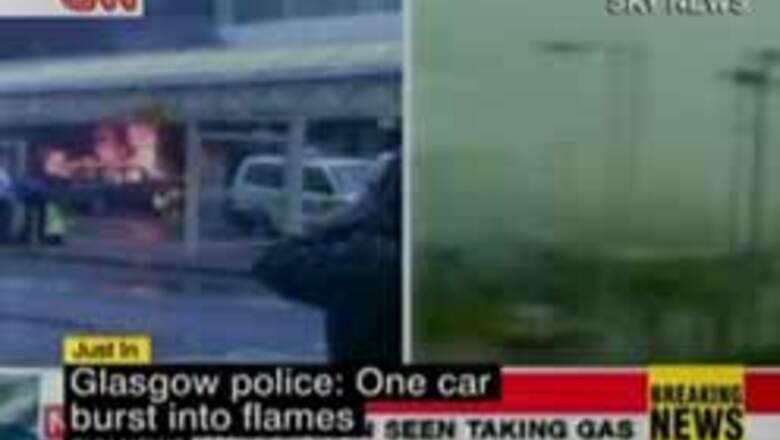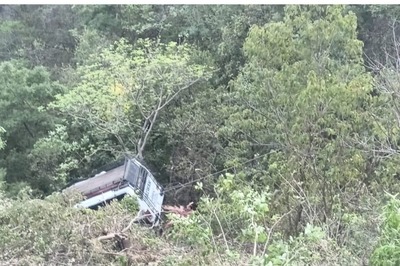
views
London: Two men rammed a flaming Jeep into the main terminal of Glasgow airport Saturday, crashing into the glass doors at the entrance and sparking a fire, witnesses said.
Police said two suspects were arrested at the scene. Police and witnesses described an SUV-style vehicle in flames being driven at full speed towards the building.
The incident comes with the UK already on alert for terror attacks a day after two cars loaded with explosives were discovered in London.
An eyewitness at the airport speaking to a British TV network said there appeared to be injuries. Images showed black smoke and flames rising from the vehicle just outside the building.
Witnesses said the car crashed into security barriers protecting an entrance to the airport's international arrivals terminal.
A witness told Sky News that a man had fled from the car as it struck the building and been immediately wrestled to the ground by police.
"The jeep is completely on fire and it exploded not long after. It exploded at the entrance to the terminal," one witness, Stephen Clarkson, told the BBC.
Airport authorities said the airport had been evacuated and all flights suspended.
In London police were examining the two cars and studying CCTV footage for clues about the identities of those behind a suspected terrorist plot that could have killed hundreds.
Officers have a "crystal clear" CCTV image of a man "staggering" from the first car after parking it outside a West End nightclub, ABC News in the US reported. Scotland Yard refused to comment.
New Prime Minister Gordon Brown went to Scotland Yard on Saturday morning for an update on the investigation from senior police.
A Downing Street spokesman told the Press Association: "It was a private meeting. Mr. Brown was briefed on the current security situation and thanked frontline staff."
Meanwhile, police increased patrols across the British capital in the hunt for what they said was a man seen running from one of the cars in the early hours of Friday.
British officials said hundreds of people could have been killed if the devices in the cars had been set off.
The first car was discovered parked near Piccadilly Circus; the second was found about an hour later, less than a kilometer away near Trafalgar Square.
PAGE_BREAK
Scotland Yard authorities said they believed the two incidents were connected.
London police said the second car -- containing fuel, gas canisters and nails -- was "clearly linked" to the first explosives-packed car found outside a nightclub on Haymarket.
A "considerable" amount of fuel and gas canisters, along with a "substantial quantity of nails," was found in the blue Mercedes-Benz 280E, said Peter Clarke, Metropolitan Police deputy assistant commissioner.
He said the second device, like the first, was "potentially viable" but was rendered safe by police explosives officers.
"These vehicles are clearly linked," he said.
The first car was discovered about 1:30 a.m. when an ambulance crew called to treat an ill person noticed what appeared to be smoke inside the car and notified authorities.
The car was parked in front of the Tiger Tiger club on Haymarket, and the discovery prompted the closing of several streets until the vehicle was hauled off nine hours later.
"In the car, they found significant quantities of petrol together with a number of gas cylinders," Clarke said. He could not immediately say how much fuel was there.
"I can tell you it was in several large containers," Clarke said. "There were also a large number of nails in the vehicle."
He said explosives officers manually disabled "a potential means of detonation for the gas and the fuel in the vehicle," which preserved crucial forensic evidence for investigators. Photo See photos of the investigation in action »
Clarke said it was too early to determine if the smoke the ambulance crew saw was an indication that the car bomb had been activated but failed to explode.
A cell phone was found as part of the device in the silver car, according to security sources with knowledge of the investigation, although it was not immediately known what role the phone may have played in the device. The sources said the device was apparently set up to be remotely detonated.
Metropolitan Police Counterterrorism Command officers are reviewing closed-circuit security camera video to see if they can determine who parked the car there, Clarke said.
Witness Daniel Weir said he was walking home from work when he noticed police had cordoned off the area around the nightclub and a nearby vehicle.
He snapped several photos, including one that showed a canister labeled "patio gas."
A second Mercedes was given a parking ticket on Cockspur Street at about 2:30 a.m. Friday (0130 GMT), Clarke said.
PAGE_BREAK
At about 3:30 am, Clarke said, the vehicle was taken to an underground car park at Hyde Park. Security sources earlier told CNN that workers who towed it thought the car smelled of petrol, and became suspicious because of the reports that petrol was among the explosive materials found in the first vehicle.
He called the discovery of the second bomb "troubling," but urged the public to remain vigilant and report suspicious behavior to authorities.Previous plots
London has a long history of bomb attacks and alerts during decades of violence mounted by Northern Irish guerrilla groups. Lone attackers also have previously targeted the city's gay and immigrant communities.
Friday's incident came days before the second anniversary of July 7, 2005, when four Islamic extremist suicide bombers killed 52 people on London's transport system in the deadliest strike on the city since World War II.
While Clarke would not speculate that Tiger Tiger was the target, he said "some features of what's happened resonate with previous plots."
"In one previous case we heard talk about nightclubs potentially becoming targets. We, of course, saw reference to vehicles being filled with gas or fuel in order to create an explosion," he said.
There had been no intelligence warning of an attack, he said.
"It is obvious that if the device had detonated there could have been significant injury or loss of life," Clarke said. "The vehicle was parked in one of the busiest parts of central London in the early hours of Friday morning when many, many people were leaving nightclubs and other places after the evening hours."
British Home Secretary Jacqui Smith said: "We're currently facing the most serious and sustained threat to our security from international terrorism."
The bombs were found just two days after Brown took office, and one day after he appointed members of his Cabinet.
"For Gordon Brown, it is a rude awakening to the realities you take on as prime minister," CNN's European political editor Robin Oakley said.
Brown, whose predecessor, Tony Blair, stoked anger among Islamic militants with his support for the Iraq war, said Britain faced "a serious and continuous threat" and the public "need to be alert" at all times.




















Comments
0 comment